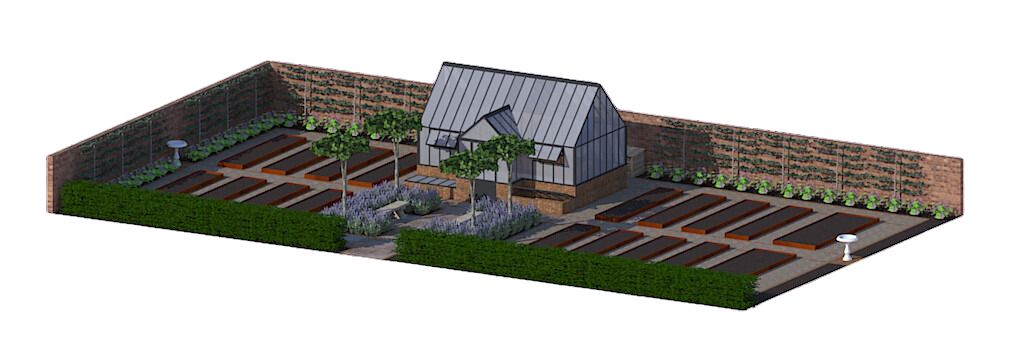
First, we had Brexit, then the pandemic and now we have unusual weather in Europe affecting the import of our veggies (if you believe that)
There are reports we should now expect drought conditions due to the lack of winter rainfall which could leave our UK commercial vegetable growers in a pickle.
If you have a sunny garden why not grow your own? You’ll be amazed at what can be grown in the smallest of spaces. Fresh, organically grown produce doesn’t get any better when it has been harvested and traveled to the plate, all in the confines of the garden.
Planning Your Vegetable Garden
The key to anything being successful in the garden is down to planning. Get this right from the start and you’ll be a success. Get it wrong and you could be making work for yourself.
Pick the Right Spot
Any place in the garden that enjoys at least half the day in direct sunlight will do. Whilst many vegetables can only be grown in full sun crops such as leafy greens, spinach, lettuce, chard & beetroot prefer a partially shaded place away from the blazing afternoon sun.
Choose Your Crops Wisely
Don’t make the mistake I made when starting and decide to grow everything. Choose crops that you enjoy and those that are matched to the amount of time you have available.
Courgettes, garlic and dwarf beans I find to be the easiest crops to grow. They do not need staking or regular feeding and offer real bang for the buck. For example, just one courgette plant will yield around 4 courgettes a week during the season £££.
Other easy crops to try are;
- Lettuce (quick to crop)
- Radishes
- Carrots
- Peas
- Tomatoes
Build Raised Beds
Despite the upfront cost growing vegetables in raised beds has many advantages;
- Separation. Keep vegetable crops separated making their individual needs easier to manage.
- Elevated growing; Raising the height allows growing crops on poor clay soil possible.
- Reduced soil compaction. It’s easy to forget and walk over ground-level vegetable beds in Winter which leads to compacted soil. Compacted soil is not good for the root systems and allows for water run-off.
- Improved Soil Quality & Weed Control. With a raised bed you can add 5 – 7cm of rich organic matter which feeds the crops and also acts as a mulch keeping weeds to a minimum and locking moisture in the soil (less watering)
The most common materials used for raised beds are timber & metal. Budget will decide whether you go simple with rough-sawn 6 x 1″ treated timber or all out with Corten steel.
Watering & Irrigation
Watering & weeding are the most time-consuming part of vegetable growing. When it comes to watering you should think about putting in a simple irrigation system that can be run on a timer.
If having multiple beds this needs to be planned from the start as supply pipes will need to be placed underground and into the raised beds.
Advantages of an automatic irrigation system include;
- Lower water bills; deliver water straight to the roots rather than wasting water on the foliage
- Watering time; it is far better to water in the morning than in the evening. This is something few working people have time for. With automatic watering set to an AM cycle, this dilemma is solved.
- Less disease; there is far less chance of fungal diseases spreading such as mildew as a leaky hose pipe is resting on the soil surface.
- Convenience; pop away for a break and rest assured you will not return to a brown parched mess.
Make Your Own Compost
The key to healthy vegetables is soil rich in nutrients and organic matter and homemade compost has it all. It’s also free!
Ensure in the planning stage you leave enough room for a compost bin.
Don’t Forget Somewhere To Sit
When in full flow vegetable gardens are stunning places to sit and relax. Full of vegetables at different stages and teeming with life.
Allow some space in your design for a chair or two. Maybe a table or even a firepit. You’ll thank me for it when enjoying a chilled glass of wine on a barmy summer’s evening.
Greenhouses
While greenhouses are the holy grail of vegetable growing they are not entirely necessary if you are just starting.
In the past have grown an entire allotment full of veg by starting seeds off on a sunny window sill, and transferring them to a cheap clear plastic-covered mini greenhouse for growing on.
Alternately there are plenty of crops that can be sown directly in the ground.
Final Word From Me
Don’t be scared! Planned and executed properly a vegetable garden is rewarding and will save you £’s especially if you enjoy organically grown produce.
You can go simple, and start with one crop or even one plant as in the case of courgettes. Alternately go large and be like Tom & Barbara from The Good Life.
The choice is yours.
